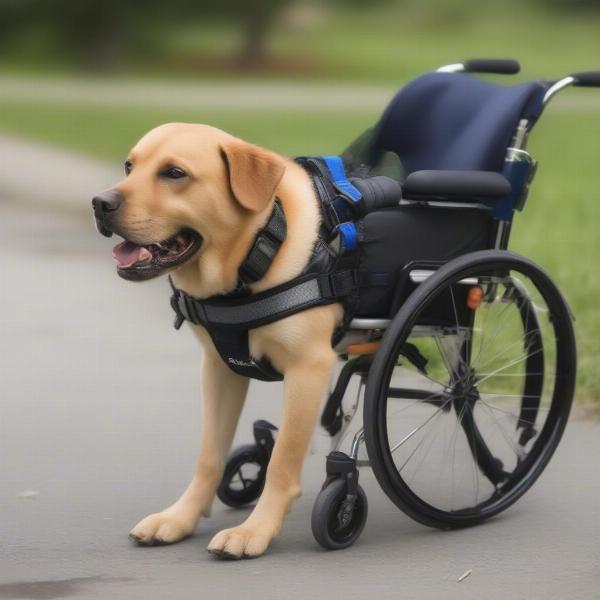Paraparesis in dogs refers to a partial loss of voluntary movement in the hind limbs. It can range from mild weakness to complete paralysis. Understanding the causes, symptoms, and treatment options is crucial for providing the best possible care for your canine companion. This article will explore the complexities of paraparesis in dogs, offering practical advice and guidance for pet owners navigating this challenging condition.
What Causes Paraparesis in Dogs?
Several factors can contribute to paraparesis in dogs, ranging from intervertebral disc disease (IVDD) and trauma to infections and tumors. Identifying the underlying cause is essential for effective treatment.
- Intervertebral Disc Disease (IVDD): This common condition occurs when the discs that cushion the vertebrae degenerate or rupture, putting pressure on the spinal cord.
- Trauma: Injuries to the spine, such as fractures or dislocations, can cause paraparesis.
- Infections: Certain infections, such as meningitis or diskospondylitis, can affect the spinal cord and lead to paraparesis.
- Tumors: Spinal cord tumors can compress the spinal cord and cause neurological dysfunction, including paraparesis.
- Degenerative Myelopathy (DM): A progressive, incurable disease of the spinal cord that primarily affects older dogs.
- Fibrocartilaginous Embolism (FCE): A sudden blockage of blood flow to the spinal cord, often caused by a piece of cartilage.
Recognizing the Signs of Paraparesis
Early detection and intervention are crucial for managing paraparesis. Be vigilant for the following signs:
- Weakness in the hind limbs: This can manifest as difficulty walking, climbing stairs, or jumping.
- Dragging of the hind paws: You might notice your dog’s paws scraping along the ground.
- Knuckling over: The paws may turn inwards or outwards while walking.
- Pain or discomfort in the back or legs: Your dog may whimper, yelp, or show signs of stiffness.
- Incontinence: Loss of bladder or bowel control.
Diagnosis and Treatment Options
If you suspect your dog has paraparesis, consult a veterinarian immediately. They will perform a thorough physical examination and may recommend diagnostic tests such as:
- X-rays: To assess the bones and joints of the spine.
- Myelography: A contrast study that provides detailed images of the spinal cord.
- MRI or CT scan: To visualize the spinal cord and surrounding tissues.
- Neurological examination: To assess the dog’s reflexes and nerve function.
Treatment for paraparesis depends on the underlying cause and the severity of the condition. Options may include:
- Medication: To reduce inflammation, manage pain, and support nerve function.
- Surgery: In cases of IVDD, tumors, or spinal fractures.
- Physical therapy: To improve strength, mobility, and coordination.
- Supportive care: Including assisting with mobility, managing incontinence, and providing a comfortable environment.
Living with a Dog with Paraparesis
Caring for a dog with paraparesis can be challenging, but with the right support and resources, you can provide a good quality of life for your pet. Consider the following:
- Mobility aids: Ramps, harnesses, and wheelchairs can help your dog navigate their surroundings.
- Bedding and environment: Provide a soft, supportive bed and ensure easy access to food and water.
- Regular exercise and physical therapy: As directed by your veterinarian, engage your dog in appropriate exercises to maintain muscle strength and prevent further decline.
 Dog with Paraparesis Using a Mobility Aid
Dog with Paraparesis Using a Mobility Aid
What is the Prognosis for Dogs with Paraparesis?
The prognosis for dogs with paraparesis varies depending on the underlying cause, severity, and response to treatment. Early diagnosis and intervention are crucial for a positive outcome.
Conclusion
Paraparesis in dogs can be a complex and challenging condition, but with proper diagnosis, treatment, and supportive care, many dogs can live fulfilling lives. Understanding the various causes, recognizing the symptoms, and working closely with your veterinarian are essential for managing this condition and providing the best possible care for your beloved companion.
FAQ
- What is the difference between paraparesis and paralysis? Paraparesis is partial paralysis, meaning there is still some voluntary movement. Paralysis is the complete loss of voluntary movement.
- Is paraparesis painful for dogs? Yes, paraparesis can be painful, particularly if it is caused by conditions like IVDD or trauma.
- Can paraparesis be cured? The potential for a cure depends on the underlying cause. Some causes are treatable and reversible, while others are progressive and incurable.
- How can I make my home more accessible for a dog with paraparesis? Use ramps for stairs, provide non-slip flooring, and ensure easy access to food, water, and bedding.
- What are the signs that my dog’s paraparesis is worsening? Increased weakness, difficulty standing, loss of bladder or bowel control, and increased pain can indicate a worsening condition.
- How often should I take my dog with paraparesis to the vet? Follow your veterinarian’s recommendations for follow-up appointments and monitoring.
- Are there any alternative therapies for dogs with paraparesis? Acupuncture, hydrotherapy, and laser therapy may be beneficial as complementary treatments, but always consult with your veterinarian before trying any alternative therapies.
ILM Dog is a leading online resource for dog owners worldwide, offering expert advice on dog breeds, health, training, nutrition, grooming, and more. We are dedicated to providing practical and reliable information to help you provide the best possible care for your canine companion. Whether you’re a new dog owner or a seasoned expert, ILM Dog has the resources you need. Contact us at [email protected] or +44 20-3965-8624 for more information. For all your dog-related needs, visit ILM Dog.